Over the years, I’ve transformed patches of soil into thriving raspberry havens, savored every sun-kissed berry, and faced every gardening challenge that came my way. Through my journey, I’ve accumulated a wealth of insights and techniques that I’m eager to share with all of you. Whether you’re a novice hoping to plant your first raspberry bush or an experienced gardener looking to refine your approach, join me as I delve into the joys and intricacies of cultivating this delightful fruit. Let’s grow together!
How to grow raspberries
Growing raspberries in your home garden is a rewarding experience that allows you to enjoy their delicious flavor and add beauty to your outdoor space. By choosing the right variety, providing the proper care, and employing good planting, pruning, and harvesting techniques, you can look forward to a bountiful harvest each year.
Raspberry plants have perennial roots that can live for decades, but each aboveground cane lives only for two years. Raspberry plants grow best when planted in light, sandy loam soil that drains out excess water easily. They do not grow nearly as well in heavy clay. Raspberries also do best when they receive a minimum of 6-8 hours of direct sunlight daily. They will grow in shadier spots but likely will struggle to produce much fruit.
Raspberries also need a dedicated trellis or another dedicated vertical support system. Protecting them from wind is also crucial. You’ll need to prune your raspberries every year, so be sure to construct your trellis in such a configuration that you can reach all areas of the raspberries easily.
In addition to annual pruning, raspberry plants are usually fed each year in about March with a fruiting plant fertilizer. Later in the spring, apply a 3-inch thick layer organic mulch to the soil around the developing canes. These berries aren’t typically affected by spring frost since their flowers bloom late.
Raspberries are self-fertile, relying on bees for pollination due to their high nectar levels. Watering the plants as the berries form is also quite important. Consistent water application at the soil line is preferred to overhead sprinklers, which leave foliage wet and can invite disease.
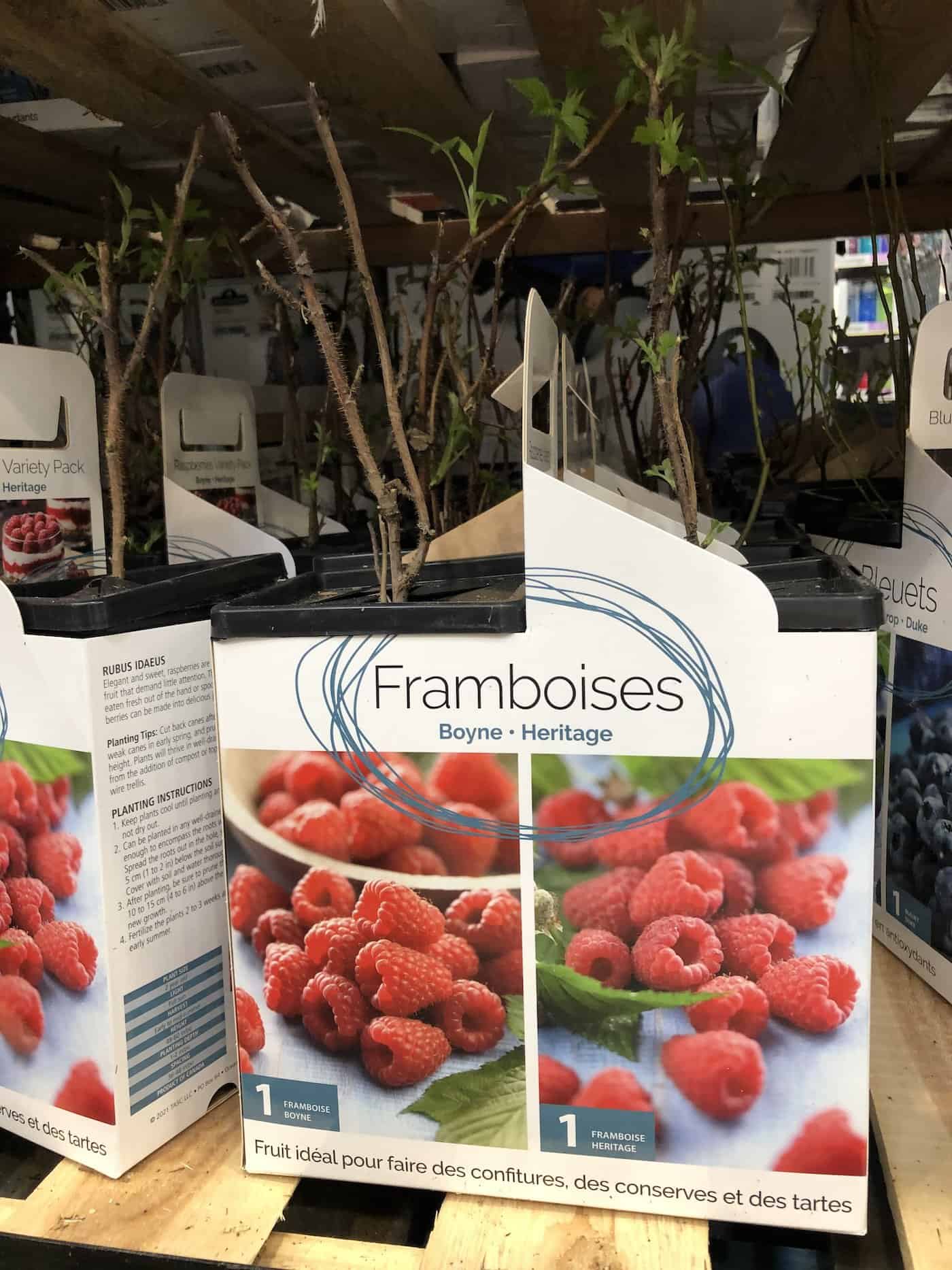
Choosing the right raspberry variety
Your raspberry-growing journey starts with the selection of the perfect variety for your garden. Raspberry varieties come in different types and colors, each with its own unique characteristics and growing requirements. We’ll examine different types of raspberries, including summer-bearing, fall-bearing, and various color options, to pave the way for an abundant harvest.
Summer-bearing vs. fall-bearing raspberries
When selecting raspberry plants, you’ll encounter two categories: summer-bearing and fall-bearing raspberries. Summer-bearers develop flower buds on first-year canes around late summer, fruiting the next year. Meanwhile, fall-fruiting raspberries bear fruits twice: once on top of the first-year canes from August to September and then a second time on the lower half the following summer. Cultivar choice depends on personal preference, with varying ripening times and flavors.
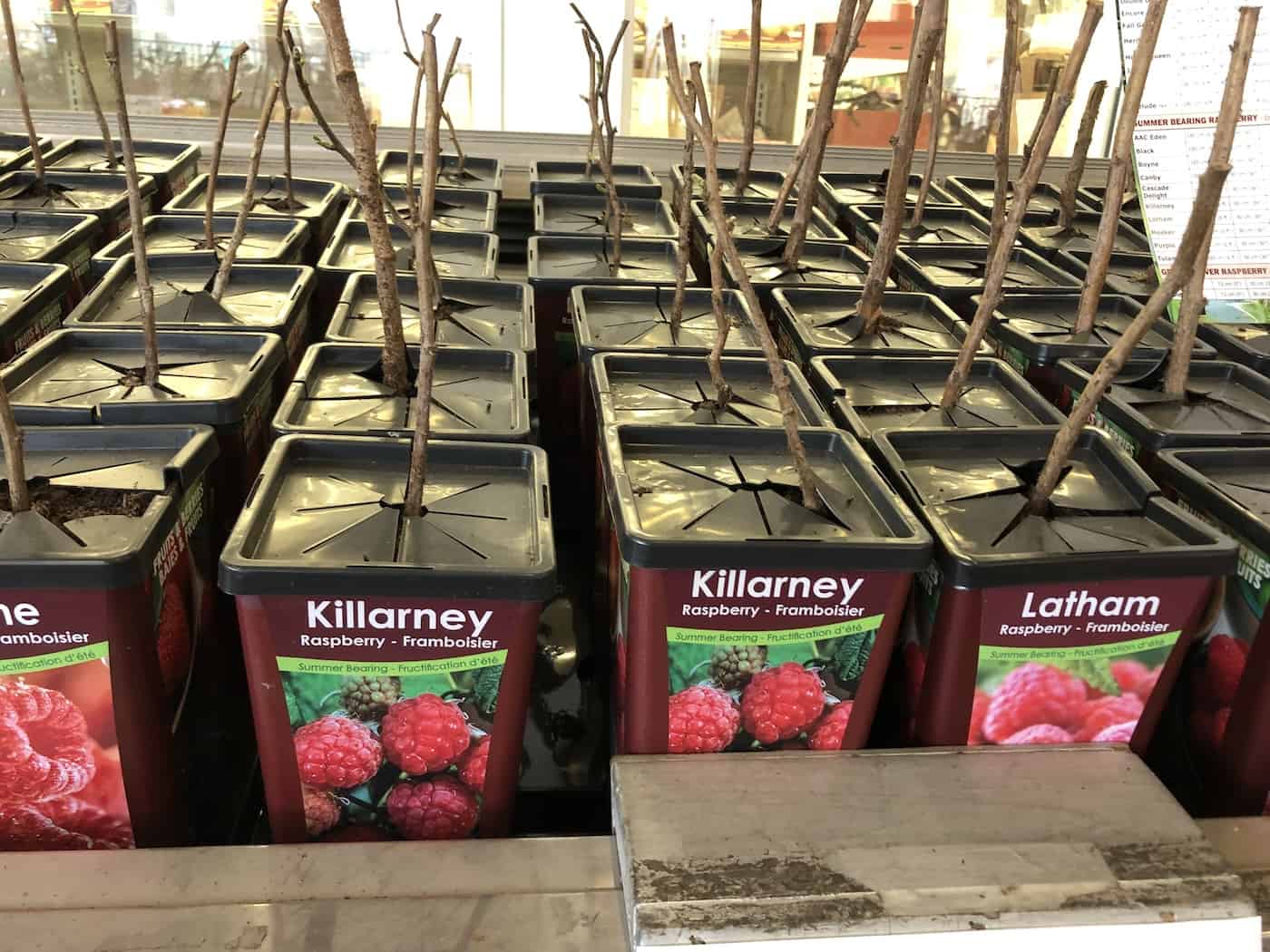
Summer-bearing raspberry cultivars
Here are some popular and well-performing summer-bearing raspberry cultivars:
- Boyne
- Tulameen
- Latham
- Willamette
- Algonquin
- Killarney
- Meeker
- Sumner
- Cascade Delight
- Chilliwack
- Centennial
Fall-bearing raspberry cultivars
Here are some popular and well-performing fall-bearing raspberry cultivars:
- Autumn Bliss
- Caroline
- Amber
- Summit
- Fall Gold
- Encore
- Heritage
- Prelude
- Nova
- Honey Queen
Color varieties
Raspberries, which grow on raspberry bushes, are ripe berries that come in an array of beautiful colors, including red, yellow, purple, and black. Each color variety has its own unique flavor profile and growing requirements.
For example, red raspberries are the most common and have a sweet, slightly tart flavor. Yellow raspberries have a milder, sweeter taste and can add a touch of novelty to your garden. Black raspberries, another variant, are different from blackberries; when picked, they are hollow. As you select your raspberry plants, keep in mind the color variety that aligns with your taste preferences.
Planting raspberries
After selecting your raspberry variety, the next step is to find the perfect spot and prepare the soil for planting. Raspberries thrive in a sunny location with nutrient-rich and well-drained soil, optimal air circulation, and protection from the wind. By providing the right environment for your raspberry plants, you set the stage for vigorous growth and a bountiful harvest.
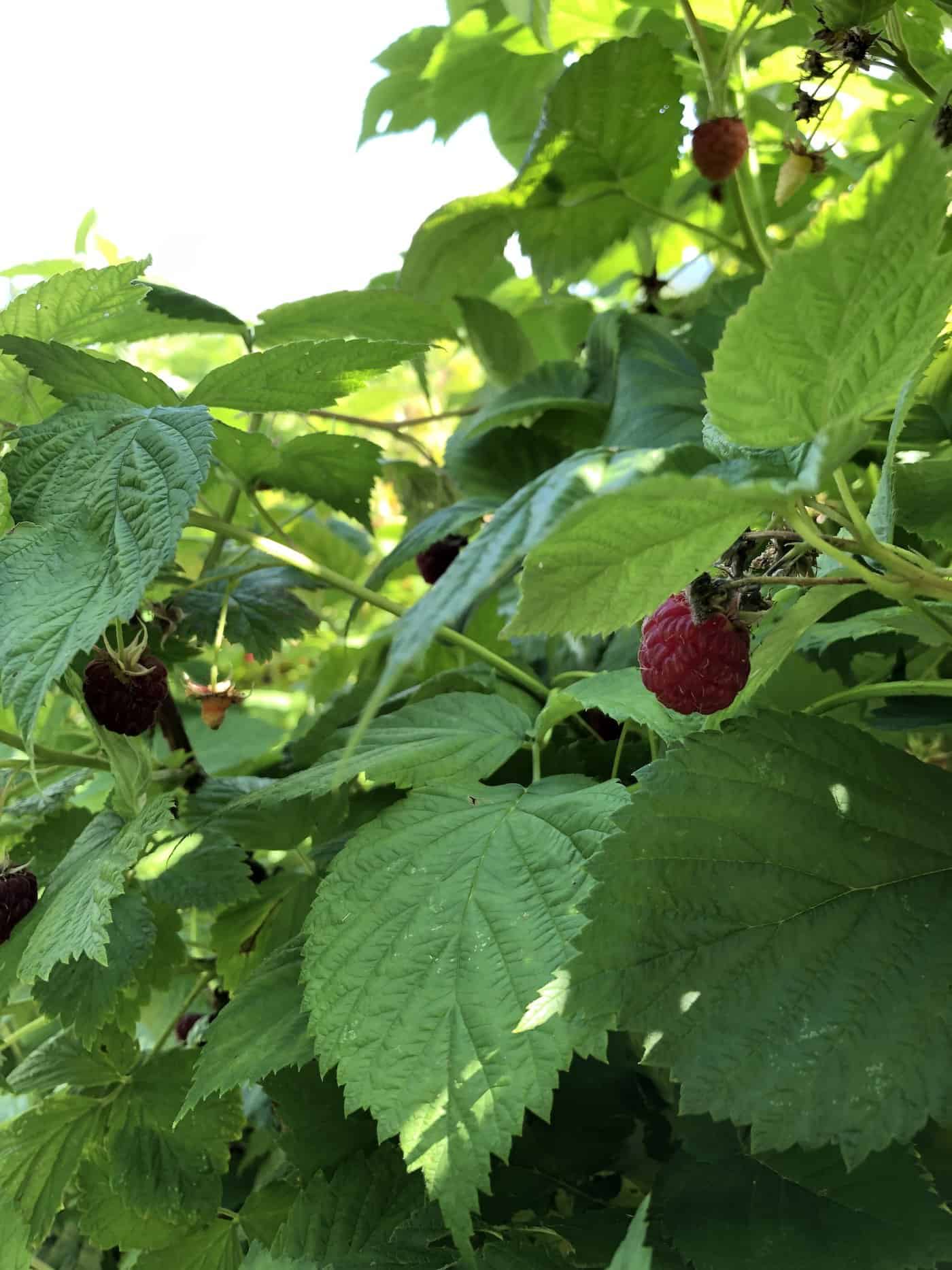
Sunlight requirements
Raspberry plants need full sun to thrive and produce the most fruit. They require 6-8 hours of direct sunlight daily and can even tolerate some shade. When selecting the planting site for your raspberries, ensure they receive adequate sunlight. This will not only promote optimal berry growth but also help prevent diseases and pests that thrive in shaded, damp conditions.
Soil and drainage
Raspberry plants do not do well in soil that stays consistently wet. They need well-drained soil to thrive. A sandy loam enriched with compost is ideal. In areas with poor soil drainage, consider using raised beds to ensure proper drainage and prevent root rot.
Raspberries prefer a soil pH of around 6.0, but are not overly picky as long as the soil drains well. Test the soil and adjust the pH if necessary. Add compost or aged manure to the soil a couple of weeks before planting to enrich the soil and promote healthy plant growth.
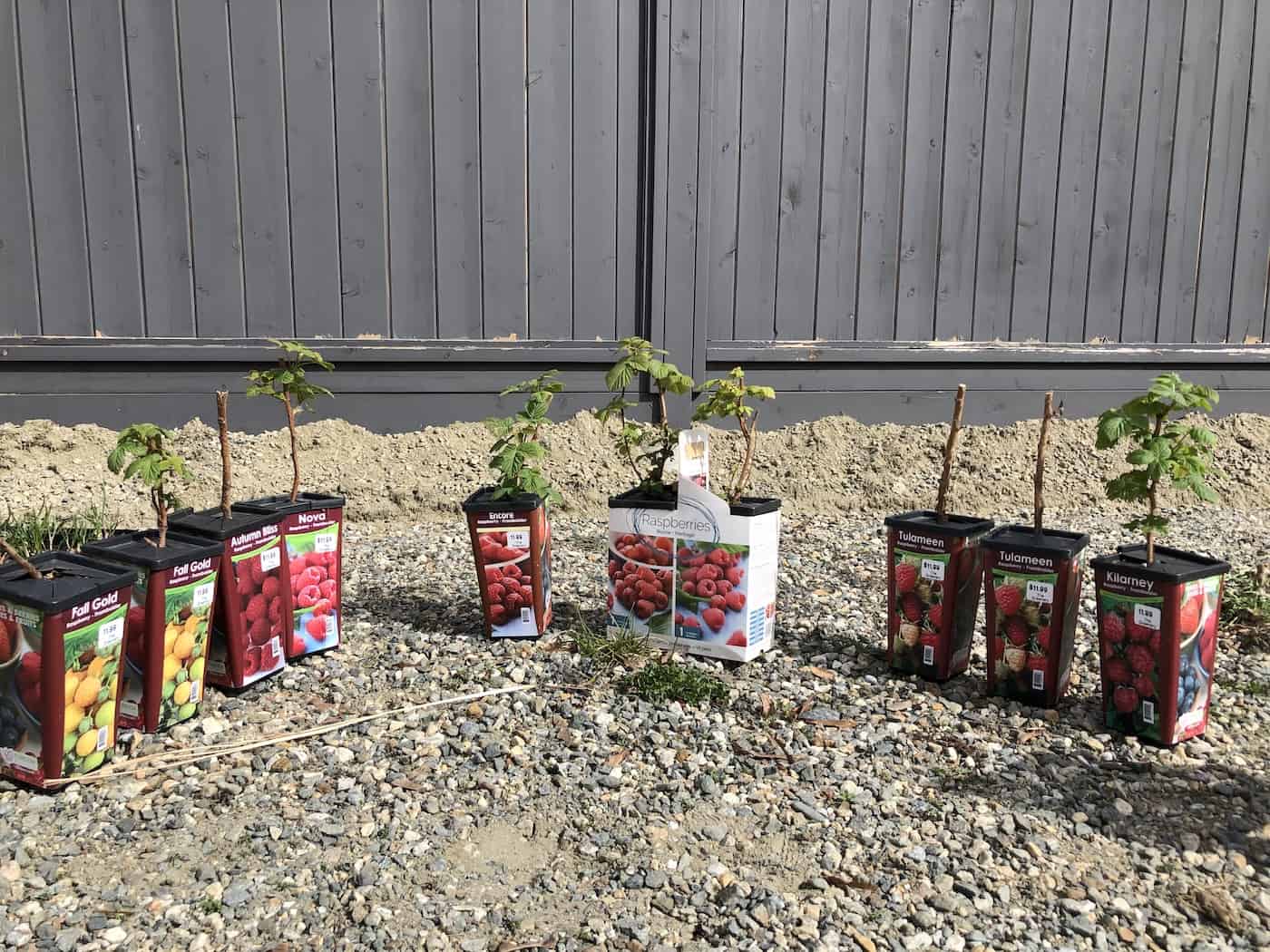
Planting raspberries
Once you have the perfect location and prepared soil, it’s time to understand the optimal planting techniques and timing for raspberries. Proper planting ensures your plants develop strong root systems and grow into healthy, productive bushes. We’ll explore the optimal planting time and techniques for spacing and depth to ensure the successful growth of your raspberries.
When to plant new raspberries
The ideal time to plant raspberries is in early spring or summer, as soon as the ground thaws out and can be worked. Planting during this time allows your raspberry plants to establish themselves before the growing season begins, setting the stage for a successful harvest.
If you’re planting container-grown plants, they can be transplanted in the summer, but be prepared to provide extra care during hot weather to ensure the success of your potted transplants.
Plant spacing and depth
When planting your raspberry plants, proper spacing and depth are crucial for optimal growth. Space your raspberry plants about 3 feet apart, with rows 6 to 8 feet apart. This ensures adequate room for growth, air circulation, and sunlight penetration, resulting in healthier plants and greater yields.
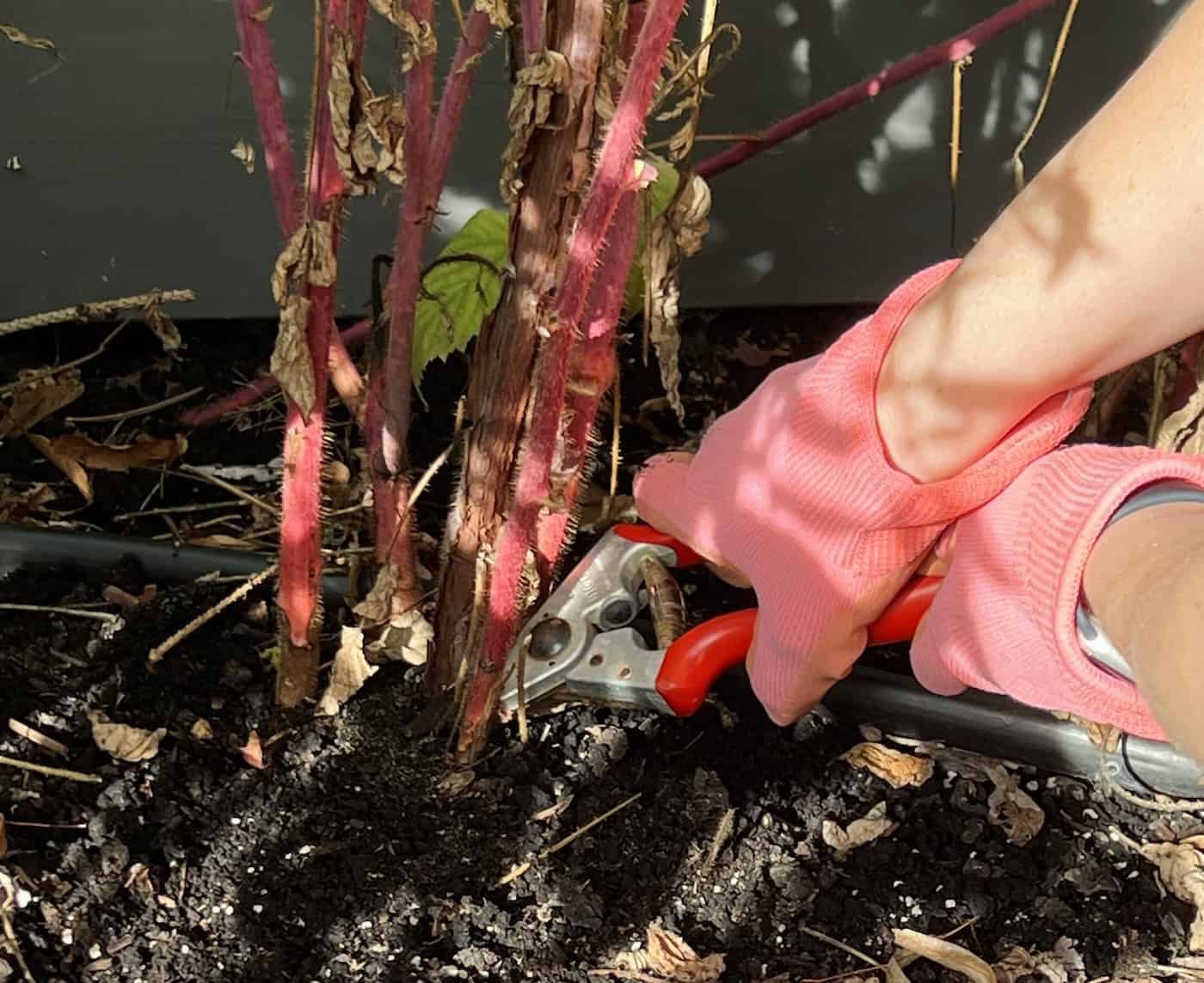
Caring for your raspberry plants
With your raspberry plants now in the ground, providing appropriate care becomes critical to guarantee their health and productivity. This includes watering, fertilizing, and providing support as they grow, especially if you start with dormant bare root plants, which are a common form of raspberry plant.
Raspberry plants usually take two years to bear fruit. Everbearing varieties can produce a bit of fruit the first year, but summer-bearing plants require pruning old fruit and canes in order to grow a summer crop during the second year. When the plants are small to begin with, however, it may take a year or two for them to come up to size enough to put on a viable crop.
Watering your plants
Raspberry plants need about 1 to 2 inches of water per week during the growing season for optimal growth. Water them thoroughly once a week, soaking the ground to a depth of 10 to 12 inches for maximum benefit.
In hot weather, they may even need water every two days or so to stay healthy and thriving. Avoid wetting the foliage and fruit if possible to prevent disease. Drip irrigation is the preferred way to water a row of raspberry plants.
Fertilizing raspberries
Raspberries are most commonly fertilized in early spring, typically around March. Use a fruiting plant fertilizer if your soil is poor. Those with rich soil may only need a bit of nitrogen fertilizer (if any). A soil test can help you determine exactly which nutrients to add.
Adding a 3-inch thick layer of organic mulch later in the spring can also help provide nutrients. In addition to adding a gentle source of minerals, it will also help keep competing weeds down.
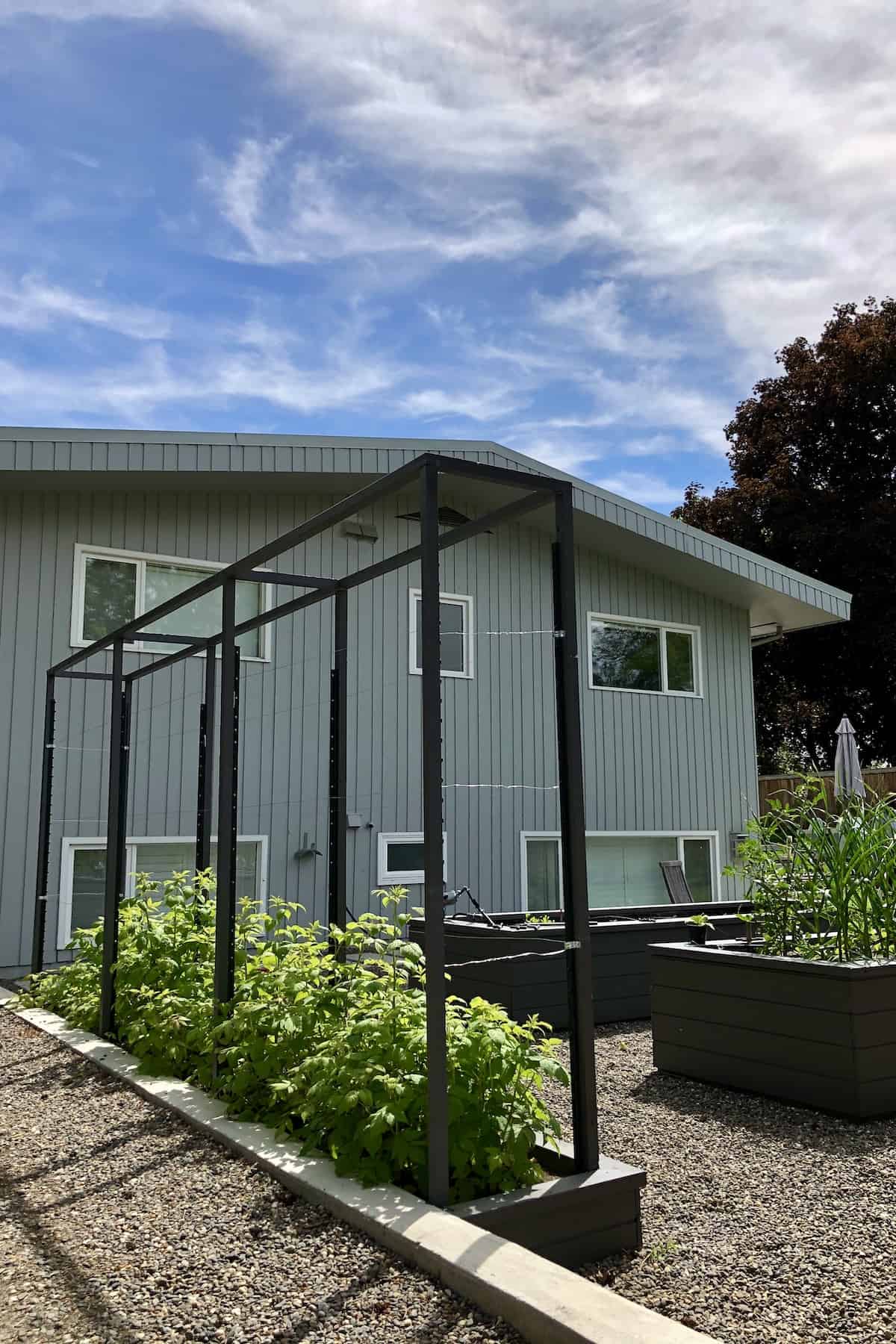
Trellising raspberries
Supporting raspberry plants with trellises or stakes helps protect them from wind damage, prevents bending or cracking, and keeps them in control. A simple trellis can be constructed using wood or metal stakes with wire or twine run between them, with the raspberry canes planted around the stakes and secured with twine.
There are lots of different ways to trellis raspberries. Ideally, the trellis should be about 6 feet tall to support your growing raspberry plants. The simplest trellis is just a pole at each end of a row of raspberries, with three wires strung between them. Providing support not only keeps your raspberry plants healthy but also makes harvesting easier.
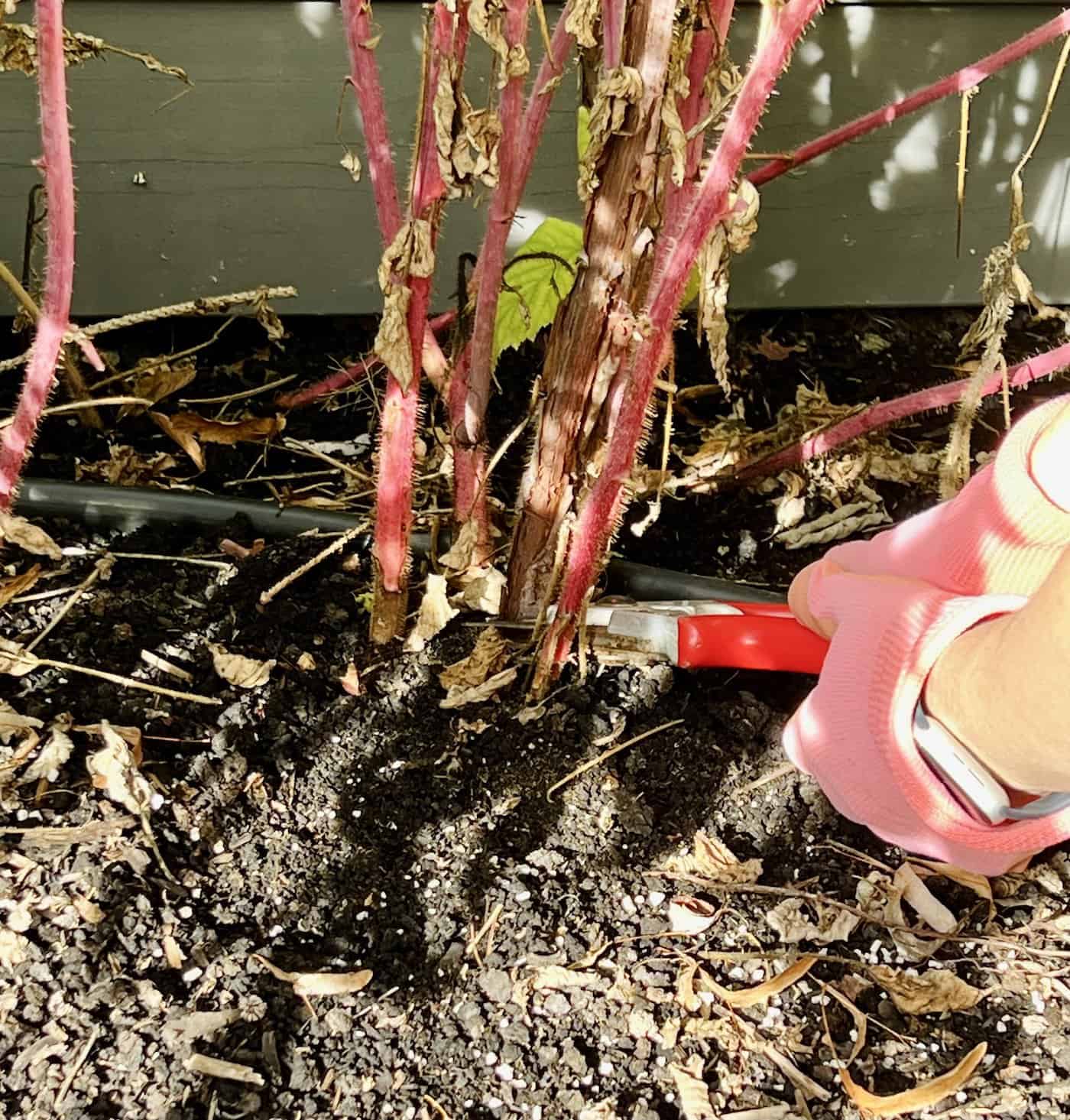
Pruning raspberries
Pruning and managing growth play a crucial role in maintaining your raspberry plants’ health and productivity. Proper pruning promotes new growth, manages plant size, and boosts fruit production.
The roots of a raspberry plant are perennial, and the roots can survive year-round in all but the coldest climates. The aboveground canes, however, are biennial, meaning that each cane lives for two years. So in terms of pruning, this means that no matter what type of raspberry you’re growing, all canes older than two years need to be cut back to ground level.
Pruning basics
Pruning raspberry plants involves eliminating dead, diseased, and weak canes, as well as redirecting canes that are growing in the wrong direction. Raspberry plants can be pruned annually during the dormant season, typically in late winter or early spring. This encourages optimal growth and fruit production by removing weak canes and keeping the healthiest ones.
How to prune raspberries
To prune your raspberries, start in the fall, if possible, by removing any dead canes and damaged branches. Then, locate any canes that have fruited already, and cut those back to the ground. Cutting out spent canes can be done as soon as you harvest, or it can be left for early spring.
The big annual pruning for raspberry plants happens in late winter or early spring. Start by cutting out any dead canes and canes that have already fruited. Then, if the row of canes is wider than about a foot, clip out some more canes to give the remaining ones more room. In general, thin to about 6 inches between canes, and the whole row shouldn’t be more than about a foot wide.
The next step is to shorten the remaining canes. How much to shorten them depends on what type of raspberries they are. If you don’t have any idea what kind they are, just cut the canes to about 6 feet tall each and try to observe where the raspberries grow later on in the summer. If you do know what kind you have, here are the more detailed instructions for summer-bearing vs. fall-bearing/everbearing:
Summer-bearing raspberries only need to be shortened for convenience and can either be trimmed to about 6 feet tall for reasonable harvesting height or simply weaved along the top wire of the trellis. Everbearing/fall-bearing plants have already fruited on the tips of the canes during the previous fall. Cut off the top portion of the cane where you can see last year’s fruit stalks so that only the lower few feet remain.
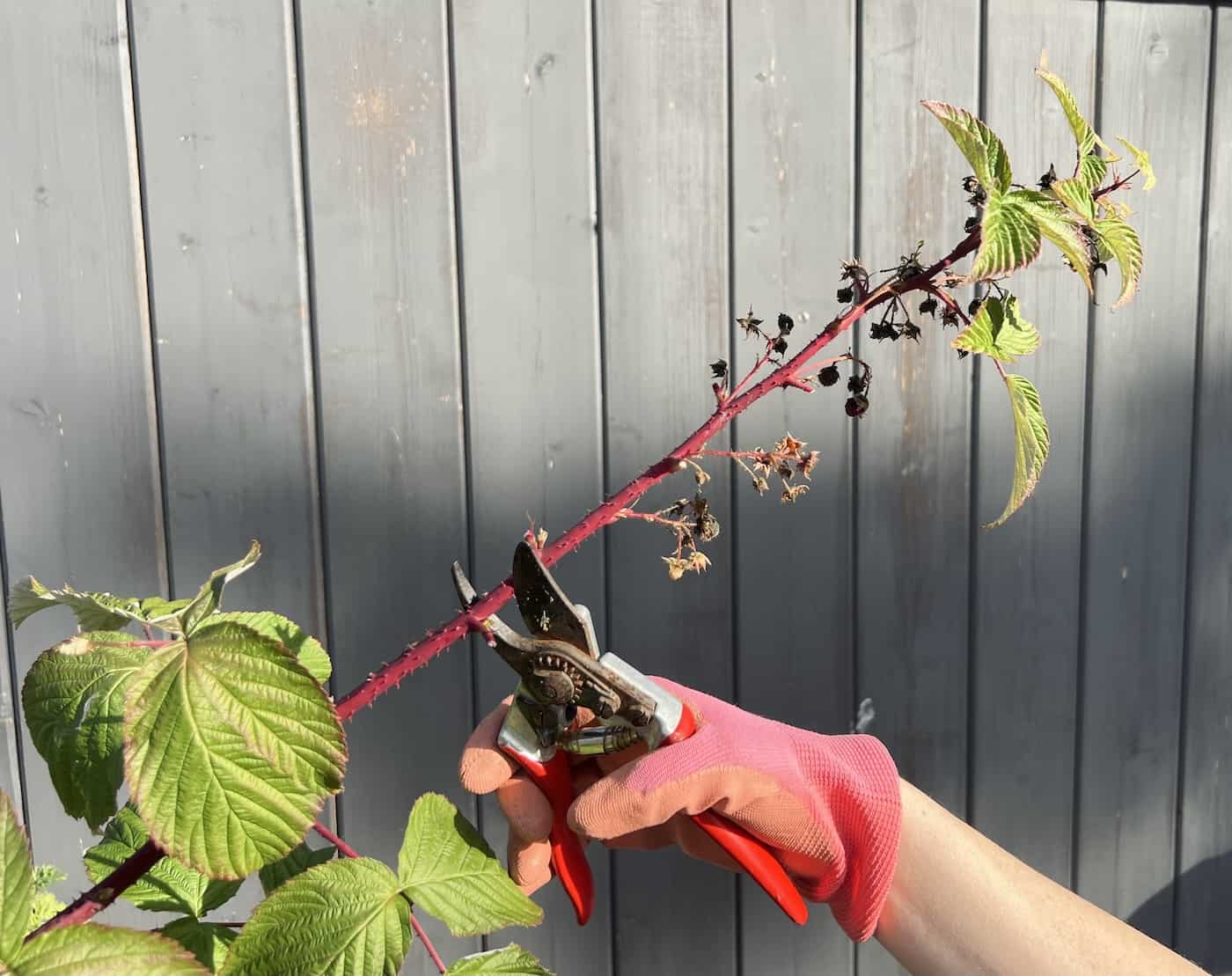
Raspberry plant pests and disease
Pests and diseases pose a threat to the growth and productivity of raspberry plants for raspberry growers. It’s crucial to prevent and manage these issues to keep a healthy and thriving garden. Common pests of raspberry plants include the raspberry crown borer, root weevil, Japanese beetles, and spider mites. In terms of disease, phytophthora root rot is the main problem.
Raspberry pests
Some common pests that may affect raspberry plants include specific borers, beetles, mites, and weevils. To manage these pests, you can use a variety of techniques such as manual removal, making your own pest spray, controlling infestations by removing infested canes and spraying infested plants with water from a garden hose targeting the underside of the leaves.
Raspberry crown borer is a fuzzy moth that looks quite a bit like a wasp. The moths lay their eggs under raspberry leaves in late summer, and the eggs hatch in early fall. The little larvae spend wintertime in the soil at the base of the plant, where they can feed on the roots. The canes above the affected roots wilt and generally die and crack off at the base by the following season. Mild infestations can be controlled with organic measures like beneficial nematodes or hungry chickens.
Raspberries can fall prey to several species of root weevils. These little beetles are distinguishable by their brown to black coloration and range from 1⁄5″ to 1⁄3″ in size, notable for their inability to fly. While adults create notches in raspberry leaves, the real concern lies with their larvae. Found in the soil, these white larvae cause significant harm by feeding on raspberry roots. Root weevils can be controlled by handpicking them off, introducing beneficial nematodes, and some organic pesticide options.
Japanese beetles are a notorious pest for raspberry plants, both in their adult and larval stages. While they relish the raspberry fruit, the larvae, known as white grubs, are particularly destructive as they feed on root tissue, leading to a decline in plant vigor.
Adult Japanese beetles are active during July-September. Females lay eggs in the soil in September. The grubs then feed underground until the frost pushes them deeper into the soil for hibernation. Come spring, they migrate upwards to feed, pupating in mid-June and emerging as adults within weeks. Management techniques include hand-picking, pheromone traps, physical barriers, and organic sprays (clay, neem).
Raspberry diseases
To prevent and treat diseases in raspberry plants, it’s essential to maintain their health through proper care, such as adequate watering, fertilizing, and pruning. Removing infected plants, pruning away infected parts, and applying fungicides can successfully treat diseases.
Additionally, employing preventive measures, such as avoiding overhead watering, removing diseased canes, and using disease-resistant varieties, can help keep your raspberry plants healthy and disease-free.
Phytophthora root rot is a pathogen known as a water mold. Water molds are filamentous protists that resemble fungi, so Phytophthora root rot is often treated like a fungal disease. First, the leaves of affected raspberry plants turn yellow, followed by canes wilting in mid-summer. Fruit on affected plants is generally small and shriveled up.
Start by choosing a disease-resistant raspberry variety. Here are some good options that have some natural resistance to Phytophthora root rot:
- Autumn Bliss
- Cascade Bounty
- Cascade Delight
- Latham
To reduce the chances of Phytophthora root rot issues, plant your raspberries in well-drained soil (or in raised beds if you have clay soil). Add some calcium to your soil if it is deficient in this key rot-fighting mineral. Gardeners with acidic soil can add calcium by adding garden lime (limestone dust), while those with neutral or alkaline soil can use gypsum.
Harvesting and storing raspberries
The best time to harvest raspberries is when they are fully ripe and have a deep, vibrant color. They should come off the torus effortlessly when lightly held between your thumb and forefinger. Frequent harvesting every two days is recommended until the plants stop bearing fruit. Be gentle while picking to avoid damaging the produce fruit or bare root plants, and wear gardening gloves to avoid getting pricked by thorns.
Storage options
Raspberries have a relatively short shelf life, so they’re best enjoyed fresh off the plants. However, they can also be stored in the refrigerator for up to three days or frozen to enjoy later. To freeze raspberries, place them on a tray in the freezer for a couple of hours to individually freeze them, then transfer them to a zip lock freezer bag or vacuum seal them for optimal storage quality.
Canning raspberries is another preservation method, allowing you to enjoy their delicious flavor throughout the year.







